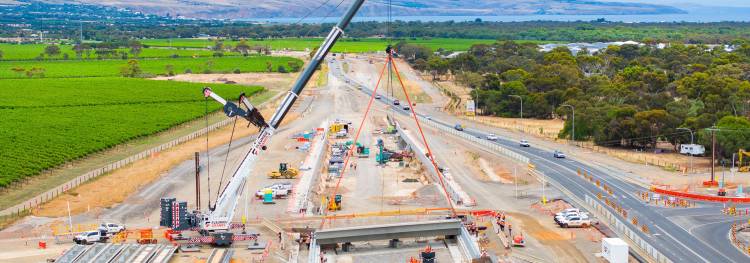From tunnels to freeway interchanges, here are four major SA road projects that will transform travel this year across Adelaide and the state.
This is the third instalment in our series on South Australia’s major roadworks. We’ve already covered upgrades in the Adelaide Hills and northern suburbs, and now we’re looking at four of the biggest projects happening across the state in 2025.
These aren’t just minor fixes – we’re talking tunnels, freeway interchanges, highway duplications, and better access for growing communities.
Yes, the roadworks might mean a few delays now, but these projects are so much more than just temporary inconveniences – they’re major investments in making South Australia’s roads safer, smoother, and ready for the future.
Whether it’s eliminating bottlenecks, cutting commute times, or ensuring regional highways can handle increasing demand, these upgrades are designed to keep South Australians moving – and safe.
Here’s a breakdown of what’s coming and why these projects are worth the wait, and how you can steer clear of the worst traffic headaches while they take shape.
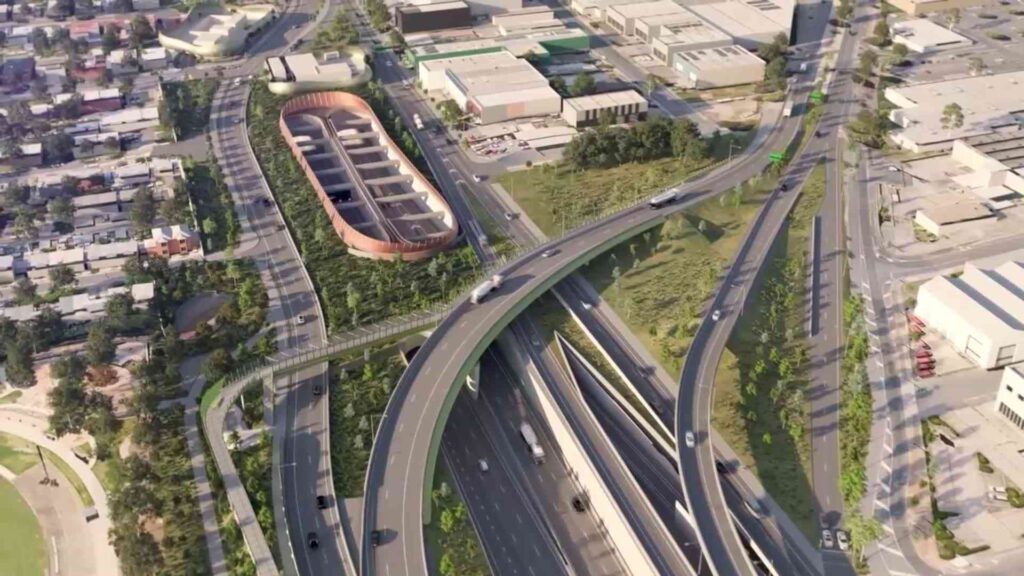
1. Torrens to Darlington (T2D): The final link in the North-South corridor
What’s happening?
The Torrens to Darlington (T2D) Project is the final section of Adelaide’s North-South Corridor. It will create a 10.5km non-stop motorway, linking the River Torrens to Darlington via two separate tunnels connected by an open motorway. Once completed, drivers will be able to bypass 21 sets of traffic lights, significantly cutting travel time and congestion.
Why?
This is South Australia’s biggest road project ever. The North-South Corridor is the backbone of Adelaide’s road network, and finishing this final section will complete a 78km uninterrupted motorway from Gawler to Old Noarlunga. That will mean a lot less gridlock, smoother freight movement, and quicker commutes.
When?
- Early works (demolition and utility relocations) are already underway.
- Main construction works are set to begin early this year.
- Tunnel Boring Machine (TBM) works for the southern tunnels are planned to begin in the second half of 2026.
- Project completion expected by 2031.
How will this help?
- Improves travel times by 30 to 40 minutes by removing 21 sets of traffic lights.
- Enhances safety with better traffic flow and reduced congestion.
- Provides better pedestrian and cycling links with five new east-west connections.
- Will support approximately 5,500 jobs per year during peak construction.
- Provides better access to travel gateways, including Adelaide Airport, Port Adelaide and the national highway network.
See the progress for yourself
Want to track how this massive project is taking shape? The T2D website has an interactive tunnel tool that shows the planned tunnel routes, depth, and key connection points.

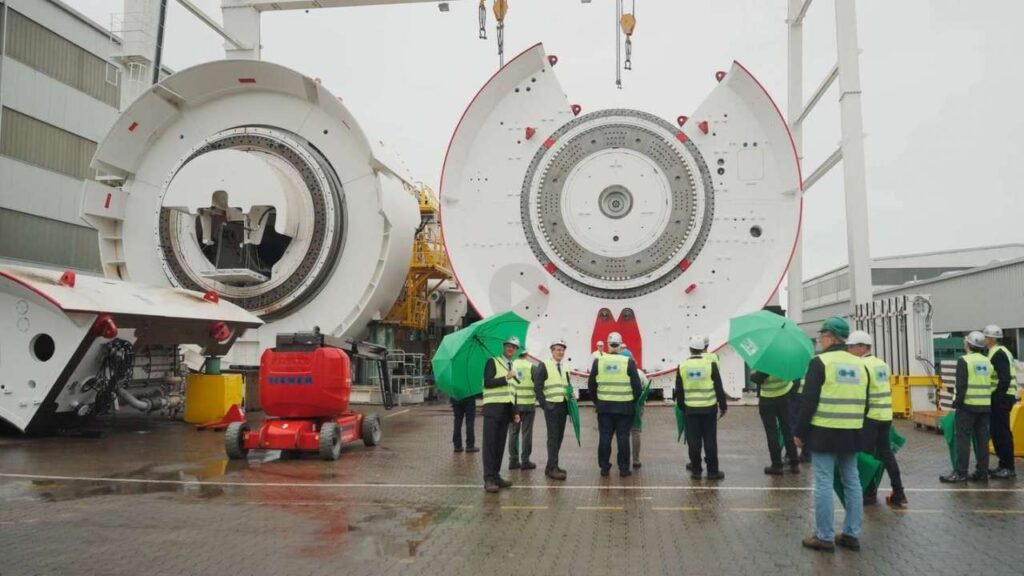
The big machines behind the build
One of the coolest parts of the T2D Project are the Tunnel Boring Machines that will carve out the tunnels. They will be approximately 15m in diameter – roughly the height of the Thebarton Theatre or Edwardstown Bunnings.
These machines will bore deep underground at around 10 to 25 metres below the surface, creating the tunnels that will finally link the North-South Corridor. The procurement of three initial TBMs for the major tunnelling work means both northern and southern tunnels can be constructed concurrently – giving a reasonable expectation that the project can not only be completed by the stated 2031 deadline, but even earlier.
What to consider when planning your journey
Check Traffic SA for live updates, and if your commute includes South Road, prepare for lane closures and diversions during key construction phases. Sign up for updates so you can stay in the know and plan ahead.
All the details: Torrens to Darlington (T2D)
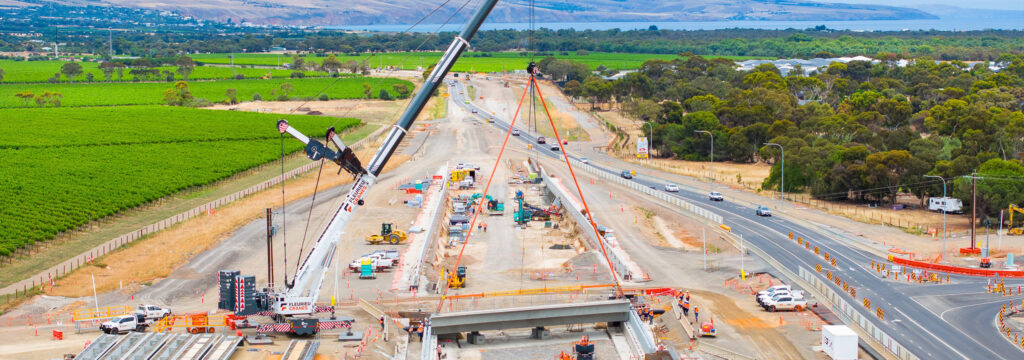
2. Main South Road duplication – Stage 2
What’s happening?
Stage 2 of the Main South Road duplication between Aldinga and Sellicks Beach is now underway. It is being delivered as part of the $810.4 million Fleurieu Connections project, funded by the South Australian and Australian governments.
Stage 2 follows the successful completion of Stage 1, the duplication of Main South Road between Seaford and Aldinga, and the Victor Harbor Road duplication, which improved safety and traffic flow from Main South Road to the McLaren Vale interchange.
Why?
The southern suburbs are growing fast, and Main South Road is a critical link between Adelaide and the Fleurieu Peninsula. This duplication will ease congestion, improve road safety, and provide better access to coastal communities.
When?
- Construction is already underway.
- The new Aldinga Bridge on Main South Road officially opened to traffic in early March.
- Expected completion: 2026.
How will this help?
- Safer, smoother travel with wide centre medians and wire rope safety barriers.
- Better intersections with key upgrades at Aldinga Beach Road, Sellicks Beach Road, and others.
- New underpass at Aldinga Road for safer crossings.
- Dedicated shared-use path for pedestrians and cyclists, connecting to Stage 1, which will provide access from Seaford to Sellicks Beach.
All the details: Main South Road duplication – stage 2
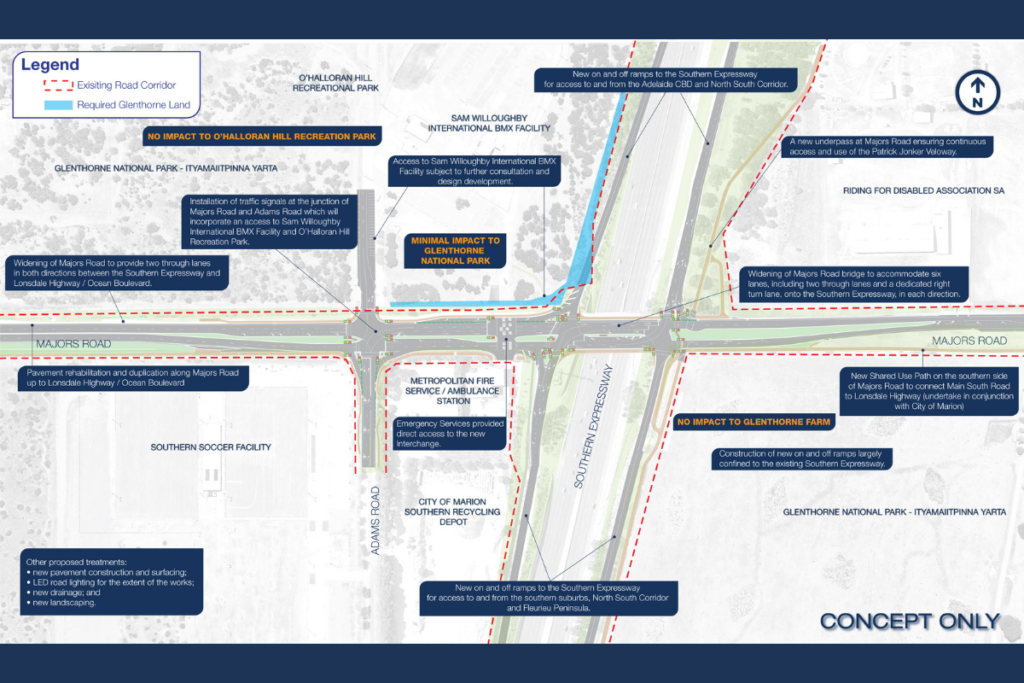
3. Majors Road Interchange: New access to the Southern Expressway
What’s happening?
A new $120 million interchange will add on/off ramps at Majors Road, improving access to the Southern Expressway and reducing travel times.
Why?
Right now, there’s no direct expressway access from Majors Road, forcing detours for southern suburbs commuters. This interchange will cut travel times and create safer and more reliable journeys. It will also provide better connections to sporting and recreational facilities, including Glenthorne National Park – Ityamaiitpinna Yarta, Sam Willoughby International BMX Facility and the Southern Soccer Facility.
When?
- Construction is underway, with completion set for late 2025.
How will this help?
- Improved access to the Southern Expressway.
- A wider Majors Road with two lanes in each direction from the Southern Expressway to Lonsdale Highway / Ocean Boulevard.
- Underground powerlines to improve amenity and safety.
- New tree planting for better roadside shade and environment.
- A new shared use path connecting two major cycling routes.
- Improved access for emergency services vehicles.
All the details: Majors Road Interchange

4. Augusta Highway duplication: A safer, smoother route north
What’s happening?
A $260 million project will duplicate 29 kilometres of the Augusta Highway between Port Wakefield to Lochiel, reducing travel time and congestion while boosting road safety and freight productivity for all motorists.
Why?
The Augusta Highway is one of SA’s most crucial regional freight routes, connecting Adelaide to the state’s industrial, mining, and agricultural regions. This duplication and the upgrades will make it safer for all users, reducing traffic delays and improving freight movement efficiency.
When?
- First stage (Port Wakefield to Beaufort) was completed in late 2023.
- Final stage (Beaufort to Lochiel) is set for completion in early 2025.
How will this help?
- Dual two-lane carriageways to ease congestion and reduce crashes.
- Better road surfaces for a smoother and more durable highway.
All the details: Augusta Highway upgrades
Plan ahead and stay informed
During major works, every effort will be made to minimise impacts, including traffic restrictions, however it is likely that there will be some lane and speed restrictions in place. If you’re commuting (and your work allows), leave a little earlier or later to dodge peak congestion.
Stay updated on road closures and detours with:
- Traffic SA – Live updates on closures and delays.
- Department for Infrastructure and Transport – Project details and timelines.
- Google Maps and Waze – Real-time traffic conditions and detour suggestions.
So next time you’re tempted to grit your teeth because of a roadwork delay, remember your short-term pain is paving the way (literally) for a faster, safer, and more connected state – which is a huge gain for every South Australian.
Missed our other deep dives into road projects for 2025? Check out our coverage of the Adelaide Hills and northern suburbs regions below.


